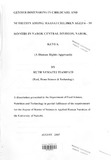| dc.description.abstract | Climate variability is a challenge to ensuring food security among populations that mainly depend on rain-fed agriculture. It affects rural women and men differently. However, there is inadequate information to link climate variability to gender and vulnerability to food insecurity. This study was conducted in Chikhwawa and Ntcheu semi-arid districts in Malawi
for this purpose. The general objective was to establish the interaction between climate variability, gender and vulnerability to food insecurity.
Data sources included household interviews, Focus Group Discussions, key informant interviews and secondary data. A Simultaneous Equation Model (SEM) estimated through a two-stage least squares approach was applied to determine the factors that influence household vulnerability to food insecurity. Since climate factors have temporal effects, time series data covering a period of 23 years were used to forecast food security using Autoregressive Integrated Moving Average (ARIMA) process.
The results provided evidence of climate variability in the study areas through deviation from the mean in the total seasonal rainfall, number of rain days and temperature. Findings from participatory approaches showed that women's daily roles mainly depend on natural' 'resources. Therefore, as the resources become scarce, more labour and time are required to meet the daily demand for resources at the household level. Hence, women have less time to engage in other activities such as education and income generating activities that can increase their adaptive capacity to climate variability. Overall, households in Chikhwawa district were more vulnerable to food insecurity than those in Ntcheu district.
The results from descriptive statistics revealed that female-headed households had low access to resources such as climate information, modern agricultural technologies, education, income and land size, implying that they were more vulnerable to food insecurity than male-headed households. SEM estimation showed that income, land size, household size, and access to modem agricultural technologies, climate information and on-farm employment had a significant influence (p :s 0.05) on household vulnerability to food insecurity. ARIMA (3, 0, 1) and (1, 0, 1) models were used to forecast food security in Chikhwawa and Ntcheu districts.
The results showed that rainfall, temperature, area under cultivation and production levels in the preceding years had a significant influence (p:S 0.05) on maize production.
This study has shown that women are more vulnerable to climate risks than men, and climate variability exacerbates their vulnerability to food insecurity by reducing the quantity and quality of resources for food production and access. The findings imply that policy interventions that enable women to gain control over cash income and land, and those that promote access to climate information, natural resources and technologies, are likely to have community benefits.
The models have revealed that household vulnerability to food insecurity is influenced by both socio-economic and climatic factors such as income, land size, household size, rainfall and temperature. Therefore, agricultural policies that support low income households to adapt through provision of farm inputs and credit facilities are crucial in empowering poor households to achieve food security. Besides, policies that promote diversification of crops and livelihoods are likely to reduce vulnerability of household to food insecurity. | en_US |

